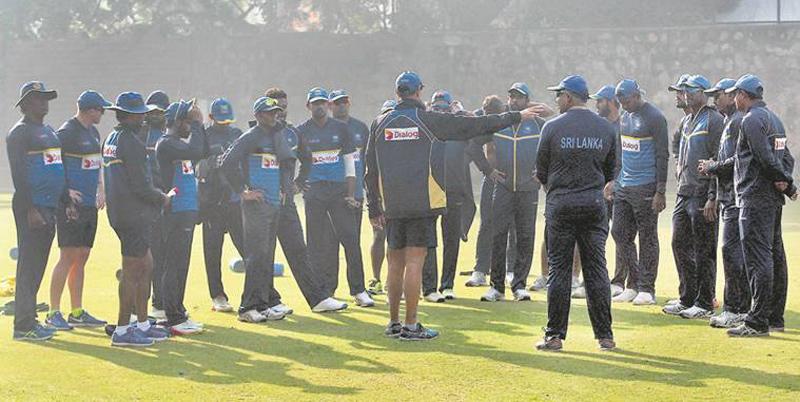
On the surface as well as at a deeper level, the disparity between India and Sri Lanka is striking.
“Bhai, pehle do din ke tickets nahi hain. Teesra din ka milega.” Snap came the reply: “Teesra din tak match jayega kya?” The conversation between a young ardent fan and a very-busy man at the ticket-kiosk closest to Feroz Shah Kotla summed up the mood of the Test series between India and Sri Lanka, the third of which began on Saturday.
Barring the opening day of the first Test at the Eden Gardens, where Suranga Lakmal enjoyed the spell of his life, it’s been India who have held the pulse over the visitors with their clinical and predominantly aggressive performance. The thumping manner of their victory in Nagpur suggest another one-sided match to unfold in Delhi. .
Such a likelihood, though, does not underwhelm the mood of the young fan. He just wants to see his team steam-roll over oppositions. He is content, if he can see Virat Kohli score another Test hundred, or Ravichandran Ashwin runs through a listless Sri Lankan batting line-up. The opposition looks almost redundant—and Sri Lanka have done little of note to change this perception.
Consider these numbers. Sri Lanka lost in Nagpur by an innings and 239 runs, their heaviest Test loss, which at the same time was India’s biggest win. This was only the second time that four Indian batsmen scored centuries in the same innings, while no one from Sri Lanka managed to reach the three-figure mark.
India have won 32 matches across all formats this year, their highest in a calendar year, and lost just one of the 10 Tests this year. Sri Lanka’s Test ambitions have taken a hit, losing seven this year, the most number they had endured in a year.
Observing the wide gulf between the two teams, former India captain Sourav Ganguly remarked: “The gap between the two sides is too much. The quality between Indian side and Sri Lanka is like chalk and cheese.”
Perhaps, the most glaring and the definitive indicator of the gulf between the two sides is the contrasting forms of their respective batting linchpins — Virat Kohli and Angelo Mathews.
Back in early 2014, the two were labelled the Asian batting stars of the future. Mathews, the composed and ever-reliable middle-order batsmen, was touted the natural successor to Sri Lanka’s batting stalwart Kumara Sangakkara. Kohli, on the other hand, had taken over the crucial No.4 spot in Tests, something which Sachin Tendulkar had made his own for over two decades.
Both began in earnest. Mathews played a key role in his side’s famous win over England on their home turf three years ago. With an average of over 76 in the three-match series, he was Sri Lanka’s best batsman. He ended that year with a coveted title — Sri Lanka’s cricketer of the year.
Kohli, too had a profitable run that year, but with an average of 44, he was nowhere close to Mathews’ levels. In the period between 2013-2015, Mathews played in 15 Tests, scoring 1533 runs with 3 Test centuries. This was, by far. the most profitable run he had in long-form cricket.
2015, the turning point
Everything changed since India’s tour to Sri Lanka in August 2015. That series proved to be the turning point in Virat Kohli’s career, both as a batsman and captain. Since then, Kohli has featured in 24 Tests, scored nine centuries, and averaged close to 70. Tragically for Sri Lanka, Mathews’ form and confidence has nosedived since.
Persistent injuries crippled his bowling, while his batting never quite rose to those stratospheric levels he had achieved in 2014. In the 15 Tests spread across the last two seasons, the 30-year-old averaged 27 with the bat, without any century, the last of his seven coming against India at SSC in 2015. Mathews’ plummeting Test career, in turn, put enormous pressure on a relatively young team in transition.
Consequently, the likes of Dinesh Chandimal and Niroshan Dickwella found it difficult to step up their game. The ongoing series mirrored their plight. Despite Mathews’ meagre haul, he was pushed to bat at No.4 spot, while captain Chandimal, who pushed him down the order, was the only batsman who looked assured.
With 166 runs, the Sri Lankan captain is his side’s highest run-scorer this series, only behind Virat Kohli and Cheteshwar Pujara.
If Sri Lanka’s batting predominantly hinged on his broad shoulders, their bowling was a two-man firm that comprised seamer Suranga Lakmal and the experienced Rangana Herath. This pair aside, the visitors got negligible support from the rest.
On Day 2 of the Nagpur Test, Herath struck beautiful lines, stifled the Indians and threatened to take a wicket any time. But off-spinner Dilruwan Perera failed to back the senior pro (and spilled a relatively easy catch of Murali Vijay at short mid-on), allowing India to score at a comfortable pace.
In doing so, he nullified the efforts of Herath. In the carnage that followed, a hapless Perera would finish with figures of 45-2-202-3 — his confidence well and truly dented.
Not a lot is expected to change over the next week as the Kotla Test gets underway.
The ardent Indian fan would want yet another comprehensive display from his team.
- Indian Express
